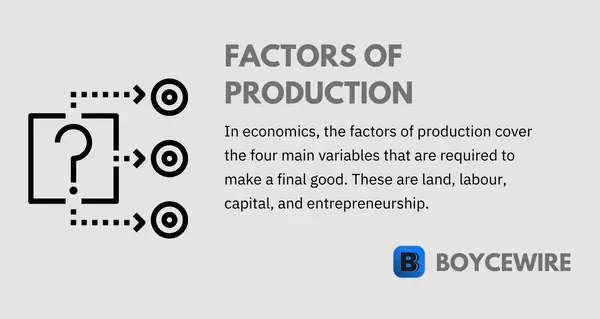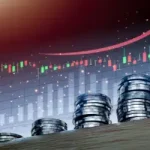Factors of Production: Definition, 4 Factors & Examples

What is a Factor of Production
In economics, the factors of production are the separate elements that work together to create a good or service. These include labour, land, and capital. All three are necessary in order to create the final good or service we consume. Whether it’s the bread we eat or the entertainment we consume.
For example, a manufacturer requires the labour of staff members to service the machines and conduct quality checks. It requires land for its factory, and it requires capital to pay for the land, rent, employees, and the supplies it needs
Key Points
- There are four main factors of production; land, labour, capital, and entrepreneurship.
- The factors of production come together to create an economic output.
- Each industry depends on one factor more than another. For instance, some are capital intensive such as oil extraction, whilst others are labour intensive, such as restaurants.
The level by which labour is required over the capital, or capital over land, can vary; with the relationship between them called the production function. Quite simply, the production function calculates the amount of labour, capital, and land that would produce the optimal level of output.
These are the traditional factors of production, but we can also include entrepreneurship in this category. Whilst not tangible, it is definitely a factor of production, for, without it, labour, land, and capital all go unused.
Through the entrepreneur, the other factors of production are combined to create a final product. Whether this is the iPhone, the television, or even a simple toaster. They required an entrepreneur to put their idea into action and use the other factors of production to create the product they envisaged.
Factors of Production
As we have already discussed, there are three physical factors of production in labour, land, and capital. There is also the fourth, the entrepreneur, that puts all these together to create the final product.
In a way, we can look at labour, land, and capital as the ingredients to a cake. On their own, they are just ingredients with no real purpose. The entrepreneur is the chef, and with their input, those ingredients are transformed into a beautiful and delicious cake. Now let’s look at these in more detail.
1. Labour
As a factor of production, labour covers both physical and mental labour. So, whilst towing the fields is labour, so too is working in the office at a computer. Essentially, it is any work an individual has to do to produce an output.
Labour is a very contentious component as a factor of production. The socialist viewpoint is that labour is key to creating added value. Therefore, if a good is selling for $10, the labourer should receive a large proportion, perhaps even as high as $9. This is because labour is seen as the key factor in the production process, so it should command the highest percentage of the sale.
By itself, labour is a key component. However, it equally relies of land, capital, and the entrepreneur. Capital can make labour more efficient through sophisticated machinery, whilst the entrepreneur may create a more efficient technique, such as that invented by Henry Ford with the production line.
The importance of labour as a factor of production varies by industry. For instance, capital heavy industries such as oil extraction and transport, are both highly dependent on machinery as opposed to labour. By contrast, we have industries such as healthcare and financial services that are highly reliant on labour.
Industries that have a high reliance on highly skilled labour tend to see salaries rise over and above inflation. This is because both the skilled labour is in short supply, but also because the goods and services provided are valued highly and are in demand. Think of healthcare, lawyers, and financial services.
By contrast, industries that rely on low skilled labour tend to see prices and wages rise slowly. Think of retail workers for example. The main difference is that they are under pressure from automation, but also the fact that the supply of workers is vast. So the comparable demand for such is low.
There are then capital intensive industries. Again, the demand for labour is low, which puts downwards pressure on wages. So we have two strings of workers. Those who are highly skilled and labor-intensive industries that see high wage rises, and those who are in either low skilled and labour intensive, or, capital intensive industries.
Over the long-term, we see a divergence in wage growth between the two strings, which has created disparities contributing to social unrest.
2. Land / Natural Resources
As a factor of production, land covers both land as well as the natural resources that it represents. So this includes the likes of coal, gas, timber, iron ore, and other natural resources.
The value of land itself tends to rise because the supply is naturally limited. If businesses want to operate specifically on the left side of Manhattan, they have to pay big money. This is because there is only so much land available there, but also so many businesses that would live to reside there. Consequently, the low level of supply and a high level of demand pushes the price up.
Natural resources themselves are different from land in the fact that some are almost unlimited in quantity. For instance, timber can be harvested and regrown; although the process is long, and there is some limitation imposed by land. Yet the majority are naturally limited, such as; gold, coal, iron ore, and oil.
The process of extracting natural resources has become more efficient, which has reduced the final price to the consumer. Yet there is a natural tendency for prices to rise above the rate of inflation in the long term if demand continues to outstrip supply.
With that said, land as a factor of production has continued to rise until more recently. In industries that rely heavily on land, such as retail, entertainment, and restaurants, the advancement of the internet has limited the need for such. Consumers can buy clothes, watch films, and even order food online; all with limited need for land.
As a factor of production, the need for land has reduced significantly in recent times. However, much of that demand has been taken by residential housing instead.
3. Capital
In economics, capital refers to something that can be used to produce revenue. As a factor of production, that includes anything from cash in hand to assets such as retail units, to equipment such as barbers’ clippers and scissors.
Adam Smith succinctly defined capital as “that part of man’s stock which he expects to afford him revenue”.
In classic economics, capital refers to financial and physical instruments that can be used to create a final product. However, in modern times, human capital and social capital have been classed under the ‘capital’ umbrella as a factor of production.
This new extended definition allows for the incorporation of more qualitative and unseen forms such as knowledge and skills within human capital. Through the knowledge and skill of the doctor, they are able to operate and remove a tumor or abscess that saves lives. The knowledge and skill of the doctor can be considered as a factor of production. For without the skill, the output would not be the same.
Furthermore, we have the social capital to consider. This covers the relationships people have with each other. For instance, knowing the right contact in a big company can get you fast-tracked through the bureaucracy involved. Knowing that someone is working on a specific project that may help you is also uniquely useful.
Social capital is the relationships we build with others and how that can then translate into increasing the efficiency in producing an output. Knowing that Bob from Finance can help you with a problem is much more efficient than asking everyone in the office.
4. Entrepreneurship
An entrepreneur is an individual that takes on the economic risk to create a business. In doing so, they combine the other three factors in land, capital, and labour, to create an output.
We can look at the entrepreneur as the chef and the other factors as the ingredients. It is the chef (entrepreneur) that mixes them together in order to create a delicious dish (a good that consumers want).
It must be said that most entrepreneurs will fail. However, those who succeed benefit from the others failures. They can learn and adapt to where others went wrong. At the same time, due to the high risk of failure, the reward for success has to be equally high. For without a high incentive, there would be few entrepreneurs.
As a factor of production, entrepreneurship is often overlooked as it is a non-physical factor. However, it is arguably the most important. For example, without Steve Jobs, thousands of workers may not be employed, land would not have been converted to factories, and capital may be diverted to more inefficient uses.
At the same time, through the innovation of Steve Jobs, it could be argued that internet shopping and Amazon may not have taken off; at least not to the extent it has.
So the role of the entrepreneur does not necessarily confine itself to their own innovation, but also how that impacts on the wider economy.
Factors of Production Examples
1. Labour as a factor of production
As a factor of production, labour can be classified under 3 categories: unskilled, semi-skilled, and skilled workers. Let us look at these examples below.
Unskilled
Unskilled labour is relatively straight forward. It doesn’t require any specific thought or judgment. Generally speaking, they are usually manual labour jobs or those that require repetitive work. Examples include:
- Parking attendant
- Cleaner / janitor
- Fast food worker
- Sewing machine operator (semi-automatic)
- Construction laborer
- Call center operator
Semi-skilled
Semi-skilled labour is slightly more advanced than unskilled labour. It requires more thought and attention to detail. However, the tasks aren’t complex with little skill, training, or education required. It may take a month to learn the job.
These jobs require some level of skill, but on a more basic level than skilled labourers. Some examples of semi-skilled jobs include:
- Salesperson
- Security guard
- Flight attendant
- Taxi driver
- Laundry operator
- Nurse’s assistant
- File clerk, and
- Fisherman.
Skilled
Skilled labourers are required to use complex analytical skills and make decisions. These roles require more thought and judgment. Such workers tend to have specific qualifications such as degrees or professional training.
Skilled labour requires the worker to use cognitive reasoning, alongside problem-solving skills. In turn, these roles are more difficult to master and tend to take the worker longer to adapt than a semi-skilled or unskilled worker.
Some examples of skilled jobs include:
- Secretary or administrative assistant
- Doctor
- Lawyer
- Teacher
- Chef
- Financial Advisor
- Accountant
2. Land as a factor of production
Land covers not only the physical space but also the natural resources that are produced by the land itself. That includes the likes of the sun, air, sea, and sand. These are all factors that cannot be moved or created.
For instance, bananas tend to grow better to hotter climates such as Brazil. The sun as a natural resource plays a crucial part in its production. In nations like Norway or Finland, the production of bananas is virtually impossible due to the lack of sunlight.
Simply put, land, as a factor of production refers to the natural elements that are limited in quantity. Some examples include:
- Oil, gas, coal
- Gold and Silver
- Iron ore
- Land
- Sea
- Rain
- Sun
3. Capital as a factor of production
In classic economics, capital generally refers to money. However, as a factor of production, money does not produce anything. It is the goods that are purchased that do. So, capital, as a factor of production, refers to the goods, purchased with money, that are able to produce further goods.
Examples such as roads or bridges are examples of infrastructural capital. They make the production and distribution of goods more efficient. When inputs such as steel are delivered to a factory, roads, and bridges are needed, so are a factor of production.
- Hairdressers clippers
- Desk and chairs
- Office buildings
- Machines
- Tools
- Roads
- Bridges
- Trucks
- Factories
4. Entrepreneurship as a factor of production
As a factor of production, entrepreneurship is the process by which the entrepreneur takes the risk of organising capital, labour, and land, to create an economic output.
Often, this takes time and personal funds to start a new enterprise. The risk is largely placed on the entrepreneur but at the same time, the financial rewards can be a huge incentive.
As a factor of production, the entrepreneur is perhaps the most important aspect. For without them, the other factors would remain idle. Let us look at some examples of famous entrepreneurs below.
- Steve Jobs
- Bill Gates
- Jeff Bezos
- Michael Bloomberg
- Mark Zuckerberg
- Amancio Ortega
- Larry Page
Even from these examples, it becomes apparent what an effect one single entrepreneur can have. Famous entrepreneurs such as Bill Gates have changed the way we work and live. Yet even smaller entrepreneurs such as the local stores have an impact. They employ people, pay them a wage, and provide them with new experiences.
For some, this can set their employees on the way to new and higher-paid roles, or even to become entrepreneurs themselves.
Related Topics
Factors of Production FAQs
There are 4 factors of production. They are: land, labour, capital, and entrepreneurship.
Factors of production are important because they help us understand how all of them combine to create a final product. It also helps us understand how these factors develop and change over time. For instance, an industry may go from being heavily labour dominated, to heavily capital intensive. These have wider implications, as such industries transition away from a labour focus, which may be contributing to wider unemployment.
Land – Oil, gas, coal, Gold, Silver, Iron ore, Land, Sea.
Labour – Doctor, Lawyer, Flight attendant, Taxi driver, Cleaner / janitor, Fast food worker.
Capital – Desk and chairs, Office buildings, Machines, Tools, Roads, Bridges, Trucks, Factories.
Entrepreneurship – Steve Jobs, Bill Gates, Jeff Bezos, Michael Bloomberg, Mark Zuckerberg, Amancio Ortega.
About Paul
Paul Boyce is an economics editor with over 10 years experience in the industry. Currently working as a consultant within the financial services sector, Paul is the CEO and chief editor of BoyceWire. He has written publications for FEE, the Mises Institute, and many others.

Further Reading
 Present Value: Definition, Criticisms & Example - Present value (PV) is the current value of a future sum of money, or stream of revenue. Tihs is calculated…
Present Value: Definition, Criticisms & Example - Present value (PV) is the current value of a future sum of money, or stream of revenue. Tihs is calculated…  Explicit and Implicit Costs: Definition & Examples - An explicit cost is the clearly stated costs that a business incurs. For example, employee wages, inputs, utility bills, and…
Explicit and Implicit Costs: Definition & Examples - An explicit cost is the clearly stated costs that a business incurs. For example, employee wages, inputs, utility bills, and…  Dynamic Pricing: Definition, Pros, Cons & Examples - Where prices actively fluctuate based on current demand.
Dynamic Pricing: Definition, Pros, Cons & Examples - Where prices actively fluctuate based on current demand. 